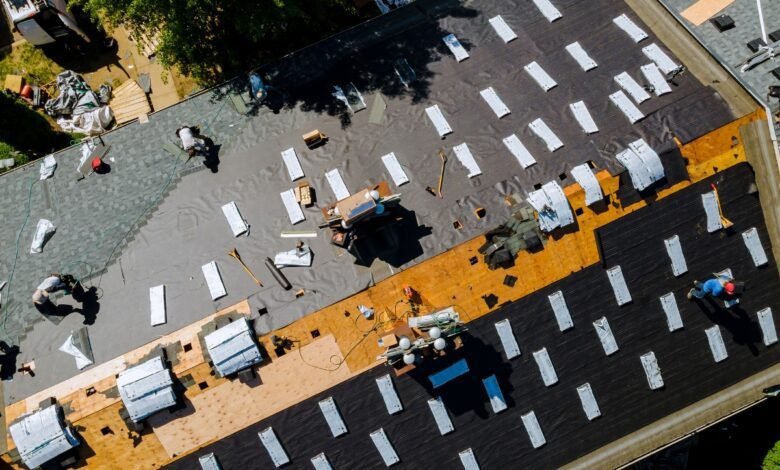A Guide to Hail-Damaged Roofs — How to Spot, Avoid and Repair

Hail storms can wreak havoc on your roof, causing dents, cracks, and even punctures that can lead to costly repairs if left unaddressed. This guide will help you spot the signs of hail storm damage roof, take preventative measures, and repair any existing damage with the help of a professional roofing company.
Identifying Hail Damage
The first step in addressing hail damage is to identify the signs. Here’s what to look for:
1. Dents and Cracks in Shingles or Tiles
Hailstones can cause visible dents and cracks in shingles or tiles, compromising their integrity and leaving your roof vulnerable to water intrusion. These dents and cracks can be visible from the ground or upon closer inspection.
2. Missing Granules from Asphalt Shingles
Asphalt shingles are coated with granules that protect the underlying material from UV rays and weather elements. Hailstones can knock off these granules, causing bald spots on the shingles. If you notice a significant amount of granules in your gutters or around your property, it could be a sign of hail damage.
3. Exposed Underlayment or Decking
In severe cases, hailstones can puncture or completely dislodge shingles or tiles, exposing the underlying roofing components, such as the underlayment or decking. This exposure can lead to water infiltration and further damage if left unaddressed.
4. Leaks or Water Stains on Ceilings or Walls
While not always immediately visible from the exterior, hail damage can cause leaks and water stains on your ceilings or walls. These stains are a clear indication that your roof has been compromised and water is seeping through, potentially causing additional damage to your home’s interior.

Preventing Hail Damage
While you can’t control the weather, there are steps you can take to minimize the impact of hail storms on your roof:
1. Regular Roof Inspections and Maintenance
Maintaining your roof in good condition is the first line of defense against hail damage. Regular inspections by a professional roofing company can identify and address any existing issues, such as loose or damaged shingles, before a hail storm strikes. Additionally, proper maintenance, such as clearing debris and trimming overhanging branches, can help prevent additional damage during severe weather events.
2. Installing Impact-Resistant Roofing Materials
When it’s time to replace your roof, consider investing in impact-resistant roofing materials. These materials are designed to withstand the force of hailstones and minimize the risk of damage. Options include impact-resistant shingles, tiles, or metal roofing systems specifically engineered to resist hail and other impact forces.
3. Considering Hail Guards or Hail Screens
Hail guards or hail screens are protective coverings that can be installed over your existing roof. These systems are designed to absorb and deflect the impact of hailstones, shielding your roof from potential damage. While an additional investment, hail guards or screens can provide an extra layer of protection and may be particularly beneficial in areas prone to frequent or severe hail storms.
While these preventative measures can help minimize the risk of hail damage, it’s important to note that no roof is entirely hail-proof. Regular inspections and prompt repairs after a hail storm are still necessary to ensure the longevity and integrity of your roof.
When to Call a Professional Roofing Company
While minor hail damage may be repairable, extensive or widespread damage often requires the expertise of a professional roofing company. Seek professional help if:
1. You Notice Multiple Leaks or Significant Water Intrusion
Multiple leaks or significant water intrusion into your home are clear signs that your roof has sustained significant damage. Attempting to repair these leaks yourself can be challenging and may not address the underlying issues. A professional roofing company has the expertise and equipment to locate the source of the leaks and properly repair or replace the damaged components, ensuring that your home is protected from further water damage.
2. The Damage Covers a Large Area of Your Roof
If the hail damage is widespread, covering a substantial portion of your roof, it’s best to seek professional assistance. Attempting to repair a large area of damage can be time-consuming, physically demanding, and may not be done correctly, leading to further issues down the line. A professional roofing company can efficiently assess the extent of the damage and provide appropriate solutions, whether it’s partial or complete roof replacement.
3. You’re Unsure of the Extent or Severity of the Damage
Assessing hail damage can be challenging, especially if you’re unfamiliar with roofing systems and materials. If you’re unsure about the extent or severity of the damage, it’s advisable to call a professional roofing company. Experienced roofers can accurately evaluate the condition of your roof and provide recommendations on the best course of action, whether it’s repairs, partial replacement, or a complete roof replacement.
By seeking professional help when hail damage is extensive or when you’re unsure of the extent of the damage, you can ensure that the repairs are done correctly and that your roof remains structurally sound and watertight. This can save you from potential headaches and costly repairs down the line.

Hail Damage Repair Options
Depending on the extent of the damage, there are various repair options available:
1. Patching or Replacing Damaged Shingles or Tiles
If the hail damage is limited to a few shingles or tiles, patching or replacing the damaged sections may be a viable option. This involves carefully removing the damaged shingles or tiles and replacing them with new, matching materials. This repair method is suitable for isolated areas of damage and can help extend the life of your existing roof.
2. Repairing or Replacing Flashings and Vents
Hailstones can also cause damage to the flashings (the metal strips used to seal roof valleys, chimneys, and other protrusions) and vents on your roof. If these components are damaged, they need to be repaired or replaced to prevent water intrusion and leaks. A professional roofer will inspect these areas and make the necessary repairs or replacements to ensure proper sealing and ventilation.
3. Complete Roof Replacement (for Severe or Widespread Damage)
In cases of severe or widespread hail damage, a complete roof replacement may be the most appropriate solution. If a significant portion of your roof has sustained extensive damage, with numerous punctures, dents, or missing shingles/tiles, attempting to patch or repair the damage may not be cost-effective or provide a long-lasting solution. A full roof replacement ensures that your home is protected with a brand-new, undamaged roofing system that meets current building codes and manufacturer specifications.
The repair option chosen will depend on several factors, including the extent and severity of the damage, the age and condition of your existing roof, and the recommendations of a professional roofing contractor. In some cases, insurance coverage may also play a role in the decision-making process.
Insurance Claims and Professional Assistance
If your roof has sustained significant hail damage, document the damage thoroughly and file an insurance claim. A professional roofing company can assist with this process, providing expertise and guidance to ensure fair compensation.
Conclusion
Hail storms can cause significant damage to your roof, compromising its structural integrity and leading to leaks and further deterioration. Regular inspections, preventative measures, and prompt repairs by a professional roofing company are crucial to maintaining the safety and longevity of your home. Don’t hesitate to seek professional assistance for a thorough assessment and repair of hail storm damage to your roof.



